Brunch is nearly always a weekend indulgence. It’s complicated to make on weekdays, too many calories for every day, and has a cute name that makes us feel like we are doing something a little different with our day. However, the chefs who need to cook it have differing views on its merits.
Gabrielle Hamilton of Prune on East 1st Street NYC (known for its brunch offering) admitted:
“I started brunch, frankly, to make some money. Any time you have the space not generating dollars … especially in a place like this – we have the engine of a 65-seat restaurant with only 30 seats, so brunch became a pretty obvious way to offset being in the hole all the time.”
Chef writer Anthony Bourdain was more scathing. He said of brunch:
“A horrible, cynical way of unloading leftovers and charging three times as much as you ordinarily charge for breakfast. It’s the least popular shift for cooks. I personally hate it. I’ve all sorts of deep, highly traumatic memories of my years cooking brunch. Hideous.”
Among the staples of a good brunch is eggs Benedict. The history of eggs Benedict is essentially a three-urinal pissing contest between three people called Benedict. All of the micturators are dead, so the truth will never be known. Here are the three claims:
- 1894. Wall Street banker Lemuel Benedict had one hell of a hangover, and wandered into the Waldorf Astoria hotel, which stood on the site of the current Empire State Building. There, he was served by the legendary maitre d’ Oscar Tchirky – he who invented Waldorf salad. Benedict asked for “Buttered toast, poached eggs, crisp bacon, and a hooker of hollandaise.” Tchirky was so taken with the idea, he put it on the Waldorf Astoria menu, swapping the bacon for ham and the toast for an English muffin.
- 1860. Mrs Le Grand Benedict (what a hell of a name) went to Delmonico’s at 2 South William Street New York, and announced that everything on the menu was crap and she wanted something new and interesting. Chef Charles Ranhofer came up with ‘oeufs a’ la Benedick,’ the recipe of which was published in The Epicurean in 1894.
- Date unknown. Edward P Montgomery made an egg dish for the New York banker and yachtsman Commodore Elias Cornelius Benedict, but it did not include hollandaise.
Of those three, we can cast out the last one as it is nothing like the other two dishes. This leaves the Waldorf Astoria and Delmonico’s left in the race to pass water. Which won, we will never know.
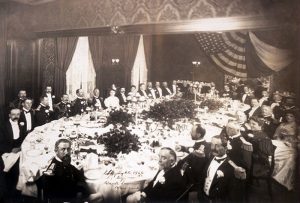
When we make eggs Benedict we do the hollandaise in the classic manner. In the UK, we don’t have the traditional ‘Canadian bacon’ as such but we do have dry-cured back bacon, which is essentially the same thing. We often cook that using a microwave-based stunt learned from Marco Pierre White – otherwise we fry it from cold (place in a cold pan and bring up to heat). The muffin is halved using Gabrielle Hamilton’s technique of pushing a fork in all around the edge of the muffin before separating the halves. Finally we use the freshest eggs we possibly can, and these are from Farm Girl at New House Farm, The Wash, High Peak. Poached eggs are impossible without farm freshness.
The care and attention that eggs Benedict demands came under direct fire in January 2019. Twitter contributor Thomas Hesketh ordered eggs Benedict from the café at Tesco in Wigan. What he received was … well this:
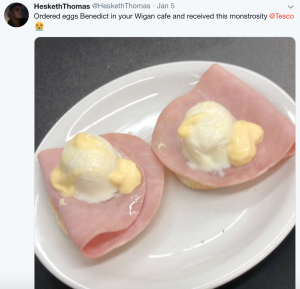
Various Twitter people – us included – went to town on Tesco over this. As a delivered food item, this dish shows a total lack of care. The fact that Mr Hesketh asked if they could make another, and the store said that it would “be the same,” shows a lack of understanding of what makes an eggs Benedict so nice. Nevertheless, Harry Harris of The Independent decided to write an article about the furore where he stated that:
“Reactions to this photo of eggs Benedict from Tesco café show just how rife middle class food snobbery has become.”
He goes on to suggest that one does not need to look very far into the Twitter comments to find people saying that Tesco does not care, and then you run across ‘restaurants’ posting photos of their own ‘Instagrammable’ eggs Benedict. The hilarious part of all that is that the ‘care’ comment and the photo were both from us.
Essentially, we had ‘triggered’ The Independent.
And you know what, Harry Harris can fuck off. He says that an eggs Benedict is:
“… a toasted English muffin, ham, a poached egg and hollandaise sauce. That is exactly the dish that was placed in front of Thomas Hesketh.”
That completely understates what the dish is really about. An eggs Benedict is a luxurious tower of toasted muffin, buttered and topped with crisped bacon or ham. A softly poached egg is perched on top, and the whole eggy skyscraper is then smothered in a fresh, zingy hollandaise. That is just not what Mr Hesketh received. To suggest that it is shows a studiously cultivated and quite deliberate class-based indignation over the idea that a dish designed for delivery in the grand dining rooms of New York would somehow not be OK in the hands of a minimum wage worker in a Tesco who is made to work with basic input ingredients and a microwave. The hilarious part is that Harry Harris suggests that our photo was shot in a restaurant and features a dish costing a lot more than £5. It wasn’t. I was shot in my kitchen and probably cost about £3 in ingredients – if that.
Up yours to The Independent on this point. And up yours to Harry Harris, who, as a journalist for the Indy, is far more middle class than he might like to think he is. Sorry, mate.
Delmonico’s can still be found at 2 South William St, New York, NY 10004, USA. This is the original 1837 restaurant (after first iteration that burned to a crisp in 1835), and is not to be confused with various other Delmonico family ventures that have thrived and failed all over NYC. The Waldorf Astoria is now at 301 Park Ave, New York, NY 10022, USA, which was not its location when eggs Benedict was created.
Eggs Benedict
Ingredients
- For the base:
- 1 English muffin
- 2 rashers of dry-cured back bacon
- For the hollandaise:
- 2 egg yolks, beaten smooth
- 2 tbsp white wine vinegar
- 2 tbsp water
- About 125g unsalted butter
- Salt and freshly ground white pepper
- Juice of half a lemon
- For the poached eggs:
- 2 farm-fresh, free-range eggs
- A splash of malt vinegar
Instructions
To make eggs Benedict, prepare your cooking area by putting an oven on low, switching on the grill, and preparing two saucepans of simmering water. Put the butter in a third saucepan on low and melt it. Take it off the heat. Preparation is everything.
Start by preparing the muffin and the bacon. Push a fork in all the way around the muffin and separate the two halves to leave you with surfaces that will crisp nicely. Place the muffins under the grill to toast. Keep a good eye on them while you cook the bacon on a plate in a microwave on high for 2.5 minutes (or fry it in a cold pan brought up to heat ... the MPW microwave trick is worth knowing though). Keep the muffin and the bacon warm in the low oven.
Reduce the vinegar and water in a small pan and allow to cool. Turn off the heat under one of the simmering saucepans and whisk about half the cooled vinegar (you don't need all the reduced vinegar, but the volume is tricky if you try to make less) with the egg yolks in a bowl set over the pan. It helps to use a hand blender if you can avoid melting the cable on the hob. You are looking for the eggs to thicken just into ribbons, but you are not putting in so much heat as to scramble them. The French call this a 'sabayon.' Gently warm the melted butter. Take the bowl with the eggs off the heat and place it on a damp tea towel to anchor it. Slowly pour in the butter while whisking. You need to be the judge here, and add enough butter to offset the vinegar and make a good balance, bearing in mind you are going to add lemon juice – you will use pretty much all the butter. Season the sauce and add the lemon to taste If the sauce is not quite thick enough, return the bowl over the warm pan and thicken some more with whisking. Take care not to over-heat the sauce. Flavour with the lemon to taste. The finished hollandaise should be set aside.
To poach the eggs, add the malt vinegar to the remaining simmering pan and turn the heat off. Swirl the water into a vortex and crack an egg into the middle. Count to five, and crack in the second egg. Leave the eggs to poach for 5 mins. Once 5 mins is up, gently lift an egg clear of the water to check for done-ness. If OK, lift out fully and blot the spoon on a folded paper towel. Use more paper to touch the egg to draw up any remaining water. Repeat with the second egg.
To assemble, warm the hollandaise over the warm pan if needed, butter the muffin halves, and put the bacon on top (I sometimes cut it with a ring that matches the size of the muffin). Place a poached egg on each, and pour over the hollandaise.
Garnish with chives, parsley or a pinch of cayenne pepper.
Notes
The hollandaise quantity used here is probably twice what you need (so it will do two servings of eggs Benedict), and is half a 'full recipe.' To make more, double the eggs, use 250g butter, twice the lemon, but the same amount of vinegar/water reduction.

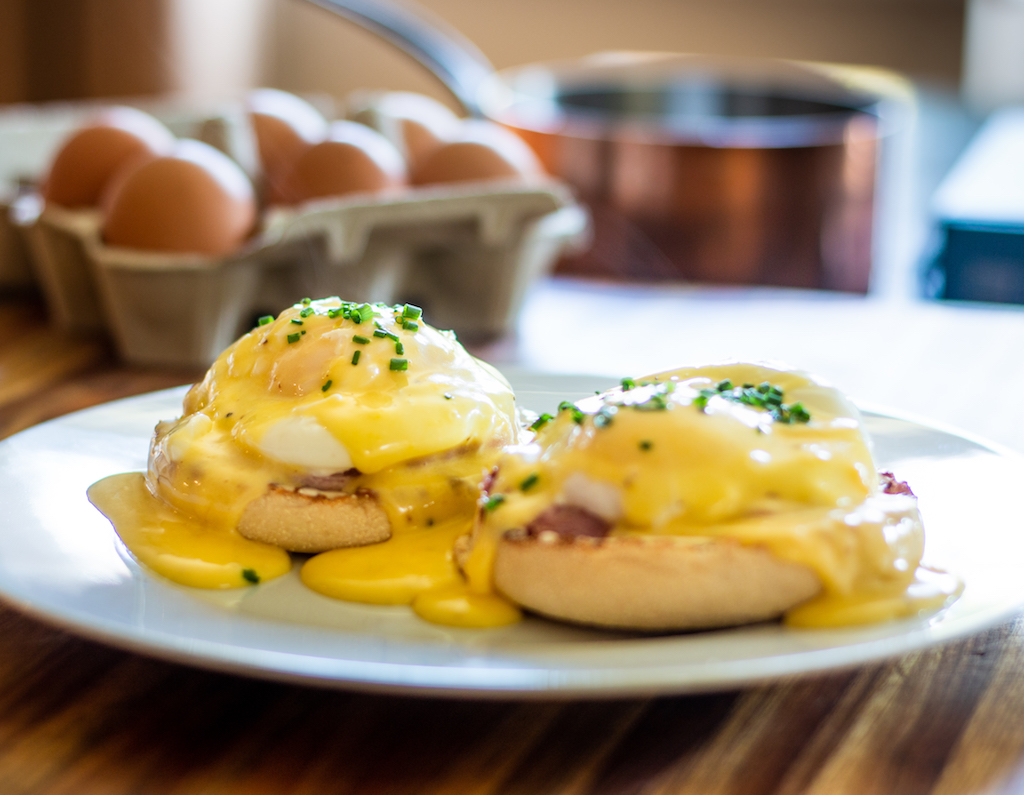

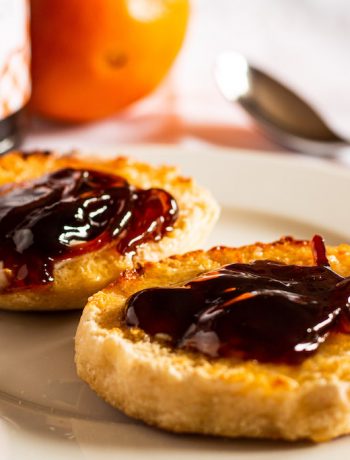
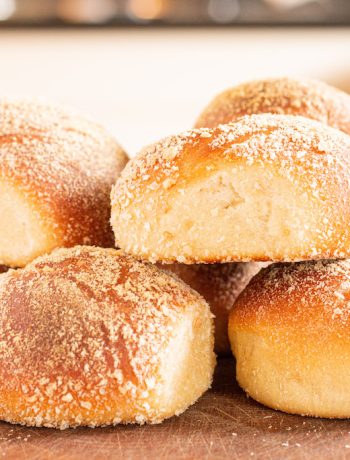

No Comments